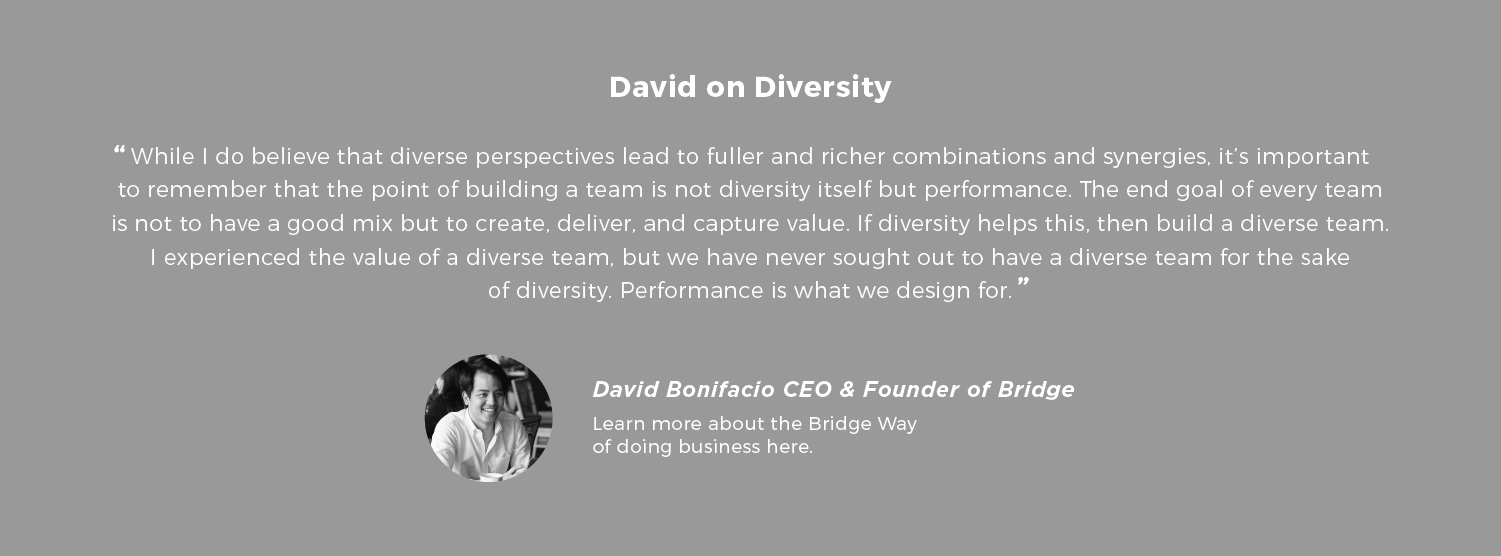In a recent interview on CNN Philippines, I’d claimed that the gender inequality in the workforce only exists if we allow it, pertaining more to the individual. If a woman chooses to let herself be deterred just because there are more men than women in the office or that men are earning more – then yes, for them, the gender gap does matter. What I’d missed to articulate was that while it is, in the end, up to an individual, company policies and maybe even more importantly, culture is an important factor in achieving gender equality in the workplace.

Photo taken during Bridge’s Christmas Party 2018
I am fortunate to be working for a company that is not just concerned about gender equality, but imbibes in all respects – gender neutrality. At Bridge, gender is never a point of consideration for remuneration, nor advancement, or even just plain being heard. In fact – Bridge’s leaders are majority female – with women leading both of its tech teams on the People Solutions and the Access business even while the teams are mostly male. I say gender neutrality – because this is not a result of deliberate moves to achieve gender equality (and NO coincidence either). This is a result of an overriding culture of respect, understanding, accountability – and ultimately embracing the idea of the AND over the ORs.
This gender neutral culture is so apparent here because while I have never allowed it to be a hindrance, I have worked for and with companies where it still felt like there was a glass ceiling that had to be broken, an Old Boys’ Club that had to be ‘infiltrated’ or broken up. So what can a company do to create the culture of gender neutrality ? I draw a few key shifts:
1. Leaders walk the talk vs. just supporting diversity initiatives for the sake of saying they do
Leaders and managers need to acknowledge and confront their own gender biases (really, we all have them) and shift the focus to the individual and the individual’s performance. Beyond just supporting women empowerment and diversity projects – leaders need to be more aware of how they communicate to and lead their employees. It has to be apparent and clear to everyone in the workplace that the company is doing something and is serious about addressing gender inequality.
2. Encourage a culture of open and honest communication
Both leaders and staff need to be able to call each other out or report when an offense is made or taken. In an age where political correctness and gender sensitivity is almost a given, this might be made unconsciously. Ideally, colleagues need to be able to say to another – “that is slightly offensive” or “that sounds discriminatory”. As a safeguard – a role or unit can be setup as an outlet to report certain sensitive cases. It is important that this unit is perceived as both safe and effective – for it to be trusted and actually utilized. Part of establishing effectivity is by setting an example when an incident does happen . These should not be tolerated and appropriate action need to be taken.
3. Promote an empowering environment of respect and understanding
Employees need to know that they are given the freedom to express themselves within the bounds of business etiquette set by the company. The policies need to be flexible to allow concessions based on an individual’s needs and in certain cases, preferences. Some companies do this by reviewing their dress code policies – to allow employees to dress how they want on certain days. Flexible work from home policies also allow both men and women to perform parental duties when needed. Company events can also be very helpful for employees to be able to get to know each other as individuals outside the workplace encourages better understanding of each other.
Just based on my experience at Bridge and like-minded companies alone, a culture where gender is a non-issue allows for both men and women to be empowered as productive contributors to the organization – creating a diversified leadership team and upwardly mobile workforce that can focus on being a productive contributor versus abolishing the patriarchy or proving themselves worthy. The company only serves to gain from the diversity – a more diversified workforce allows for healthier idea generation and exchange and is able to draw from the varied strengths of each individual. When gender is not the issue, the company’s mission can again become the focus.
* * * * *
* * * * *



